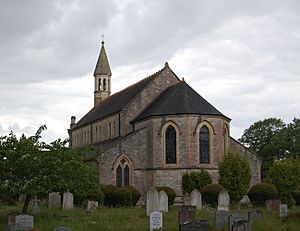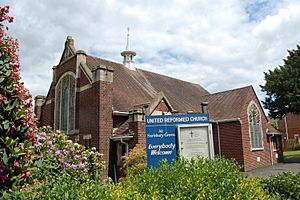List of places of worship in the Borough of Fareham facts for kids
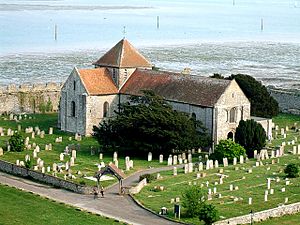
The Borough of Fareham in Hampshire, England, is home to many churches and other places of worship. There are 37 buildings currently used by different Christian denominations. Three other buildings used to be places of worship but are now used for other things. Fareham is a town and borough in southern England, located between the cities of Southampton and Portsmouth. It includes the old market town of Fareham and many villages that have grown into suburbs, like Portchester, Sarisbury, Swanwick and Warsash.
Most people in Fareham identify as Christian, according to the 2011 census. The largest number of churches belong to the Church of England, which is the official church of England. Some very old Church of England churches, like those in Titchfield and Portchester, are still in use today. Many more were built during the Victorian era as villages grew. Other Christian groups, called Nonconformists, also started meeting in the area in the early 1800s. These include Congregationalists, Methodists, and Strict Baptists. The first Roman Catholic church in the borough was built in 1878, but most others are newer. Smaller groups like Jehovah's Witnesses and the Plymouth Brethren Christian Church also have places of worship here.
Many of these buildings are considered special because of their history or architecture. Historic England, a government body, gives them "listed status." This means they are protected. Buildings can be Grade I (most important), Grade II* (very important), or Grade II (special interest).
Contents
Exploring Fareham's Places of Worship
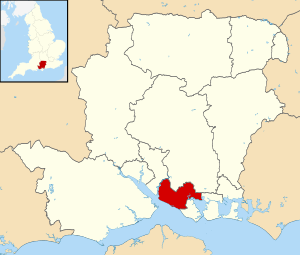
The Borough of Fareham is in southern Hampshire. It covers about 7,423 hectares (18,343 acres) and had over 110,000 people in 2011. Most of the people live in built-up areas. Water surrounds the borough on three sides: the River Hamble to the west, The Solent to the southwest, and parts of Portsmouth Harbour to the southeast.
Ancient Churches and Their Beginnings
Christianity is thought to have arrived in this area around 648 AD with Saint Wilfrid. St Peter's Church at Titchfield is one of the oldest churches, possibly dating back to 700 AD. You can still see some of its original Anglo-Saxon stonework. St Mary's Church at Portchester is another ancient church, built around 1130. It's a great example of Norman architecture and still has its original cross shape. By the end of the Middle Ages, Fareham town had its own church, St Peter and St Paul. It started as a small chapel but has been made much bigger over time.
How Churches Grew in the 1800s
As the population grew in the 19th and 20th centuries, especially in the large Titchfield area, new churches were needed. The Titchfield church area was divided five times to create six new church areas. The first new church area was Sarisbury with Swanwick in 1837. Then came Crofton in 1871, Hook with Warsash in 1872, and Locks Heath in 1893.
The Story of Catholic Churches
Before 1873, Catholics in Fareham went to a church in Soberton. This church was started in 1747 by people who had to leave northern England because of religious persecution. In 1873, a new Catholic church started in a shed in Fareham town. The permanent Church of the Sacred Heart opened in 1878. More Catholic churches were built as the population grew, including one in Portchester (now gone), St Margaret Mary's in Park Gate (1966), and the Church of Our Lady of the Immaculate Conception in Stubbington (1985).
Nonconformist Churches and Their History
The Congregational movement, which is now part of the United Reformed Church, has been in Fareham since the 1600s. In 1836, they built a chapel in the town centre. This building was later sold and became a pub, and a new church was built nearby in 1994. Other Congregational chapels were built in Titchfield and Warsash. The church in Sarisbury Green started with meetings in homes around 1800, and a chapel was built in 1803.
Baptist churches also have a long history here. A Strict Baptist group has worshipped in Lower Swanwick since 1835. Their current chapel, built in 1844, replaced an old boat-shed that often flooded! Methodist churches in Fareham, Portchester, and Stubbington all started in the 1800s, but their current buildings are from the 1900s. A Lutheran church was founded in 1971 and had its own building from 1975 to 2002. Now, they meet in a rented hall.
Other groups like the Open Brethren also built meeting halls in various parts of Fareham, Park Gate, and Warsash throughout the 1900s. The Plymouth Brethren Christian Church opened a meeting room in Fareham in 1948.
Who Lives Here? Religious Affiliation
The 2011 census showed that 111,581 people lived in Fareham.
- 63.77% said they were Christian.
- 27.4% said they had no religion.
- 7.25% did not state their religion.
- Smaller numbers identified as Muslim (0.48%), Hindu (0.27%), Buddhist (0.25%), Sikh (0.07%), or Jewish (0.06%).
Compared to England as a whole, Fareham had more Christians and people with no religion, and fewer people from other religions.
How Churches are Organized
Anglican Churches in Fareham
All the Church of England churches in Fareham are part of the Anglican Diocese of Portsmouth. This diocese is led by the Bishop of Portsmouth and is based at Portsmouth Cathedral. The churches in Fareham, Portchester, Stubbington, Locks Heath, Hook (Warsash), Sarisbury Green, Titchfield, and Whiteley Village are all part of the Fareham Deanery.
Catholic Churches in Fareham
The Catholic churches in Fareham, Park Gate, and Stubbington belong to the Roman Catholic Diocese of Portsmouth. This diocese is based at the Cathedral of St John the Evangelist in Portsmouth. The churches in Fareham and Portchester are part of one parish, while St Margaret Mary's in Park Gate covers a wide area including Titchfield, Warsash, and Sarisbury. The Church of the Immaculate Conception in Stubbington serves Stubbington and Lee-on-the-Solent.
Other Church Groups
Fareham's three Methodist churches are part of a larger group of 23 Methodist churches called the East Solent and Downs Methodist Circuit. The Baptist churches in Fareham, Hill Park, Locks Heath, and Stubbington are part of the Southern Counties Baptist Association. Swanwick Shore Strict Baptist Chapel is linked to the Gospel Standard Baptist movement. Titchfield Evangelical Church belongs to two Evangelical groups: the Fellowship of Independent Evangelical Churches (FIEC) and Affinity.
Current Places of Worship
| Name | Image | Location | Church Group | Grade | What Makes it Special | More Info |
|---|---|---|---|---|---|---|
| Holy Trinity Church (More images) |
 |
Fareham 50°51′08″N 1°11′00″W / 50.852241°N 1.183429°W |
Anglican | II* | Built in 1834–35, this church was designed to be "light and uplifting." It's made of yellow brick and is a great example of 1830s Gothic Revival architecture. Its tall spire was removed in 1992 because it became unsafe. | |
| St Peter and St Paul's Church (More images) |
 |
Fareham 50°51′18″N 1°10′30″W / 50.855133°N 1.175087°W |
Anglican | II* | This church has parts from the Middle Ages, but most of it is from the 1700s and 1800s. The tower is from 1742, and the main part of the church was made much bigger in 1812–14. | |
| St John the Evangelist's Church (More images) |
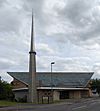 |
Fareham 50°50′52″N 1°11′30″W / 50.847658°N 1.191677°W |
Anglican | – | This church was built in 1962–64 to serve a new housing area. Its bell-tower looks like the famous Skylon tower from the Festival of Britain. It has a unique trapezoid-shaped roof. | |
| Fareham Baptist New Life Church (More images) |
 |
Fareham 50°50′44″N 1°10′57″W / 50.845600°N 1.182450°W |
Baptist | – | This Baptist church building opened in April 1932. There was an earlier Baptist chapel in Fareham recorded in 1908. | |
| Christ Church Fareham (More images) |
 |
Fareham 50°51′21″N 1°10′33″W / 50.855879°N 1.175904°W |
Evangelical | – | This church started in 2018. It meets every Sunday at Orchard Lea Junior School. The first service was held at the Ashcroft Arts Centre. | |
| Fareham Community Church (More images) |
 |
Fareham 50°51′10″N 1°11′03″W / 50.852814°N 1.184089°W |
Evangelical | – | This Evangelical church is located in a building that used to be a shop in the town centre. It was registered as a place of worship in 1998. | |
| Kingdom Hall (More images) |
 |
Fareham 50°51′43″N 1°10′30″W / 50.861954°N 1.175031°W |
Jehovah's Witnesses | – | This Kingdom Hall for Jehovah's Witnesses was built in 1990. It replaced an earlier one that was on the first floor of another building in town. | |
| Fareham Methodist Church (More images) |
 |
Fareham 50°51′06″N 1°10′55″W / 50.851676°N 1.181993°W |
Methodist | – | This is the third Methodist church building in Fareham. It opened in 1939. Many of the inside parts from the second chapel, built in 1875, were moved here. | |
| West End Chapel (More images) |
Fareham 50°50′38″N 1°11′56″W / 50.844027°N 1.198911°W |
Open Brethren | – | This chapel opened in March 1965, replacing an earlier "West End Gospel Hall" that was in a different location in Fareham. | ||
| Brethren Meeting Room (More images) |
 |
Fareham 50°51′08″N 1°11′26″W / 50.852217°N 1.190480°W |
Plymouth Brethren Christian Church | – | This meeting room opened in 1972. It replaced an earlier building on a similar site that had been used since 1948. | |
| Church of the Sacred Heart (More images) |
 |
Fareham 50°51′04″N 1°10′43″W / 50.851162°N 1.178683°W |
Roman Catholic | – | This small Gothic Revival church was built in 1878. It replaced a converted shed that opened five years earlier. The church is made of flint with some brickwork and has a steep slate roof. | |
| St Philip Howard's Church (More images) |
 |
Fareham 50°51′02″N 1°12′03″W / 50.850564°N 1.200891°W |
Roman Catholic | – | This church was built and registered in June 1980. It was founded as a "daughter church" to the Sacred Heart in the town centre. | |
| Fareham Free Seventh Day Adventist Church (More images) |
 |
Fareham 50°51′12″N 1°10′55″W / 50.853262°N 1.181922°W |
Seventh-Day Adventist | – | This building used to be a Gospel hall, which opened in 1977. It closed in 2011 and was then bought by the Free Seventh Day Adventist Church. | |
| Fareham United Reformed Church (More images) |
Fareham 50°51′15″N 1°10′58″W / 50.854187°N 1.182666°W |
United Reformed Church | – | This church was built in 1994–95 to replace an older United Reformed church in the town centre. It's a brick building with a pyramid-shaped roof. | ||
| St Columba's Church (More images) |
 |
Hill Park, Fareham 50°51′29″N 1°12′51″W / 50.858101°N 1.214288°W |
Anglican | – | A small "tin tabernacle" church was built in 1891, but it became too small. A new St Columba's Church opened in 1963. It's made of dark brick and wood. | |
| Hill Park Baptist Church (More images) |
 |
Hill Park, Fareham 50°51′38″N 1°12′28″W / 50.860492°N 1.207666°W |
Baptist | – | This site was originally the Hill Park Gospel Hall, which closed in 2004. A new Baptist church has since been built here. | |
| St Mary's Church (More images) |
 |
Hook 50°50′50″N 1°17′28″W / 50.847339°N 1.290998°W |
Anglican | II | This church was built in 1870–71. It has a mix of old English Gothic styles. It doesn't have a tall tower or spire, but a small bell-cot rises from the roof. | |
| St John the Baptist's Church (More images) |
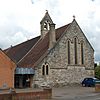 |
Locks Heath 50°51′41″N 1°15′41″W / 50.861350°N 1.261425°W |
Anglican | – | A mission chapel started here in 1886. A new church was built in 1895. The old mission church then became a school. | |
| Waypoint Church (South) (More images) |
Locks Heath 50°51′24″N 1°15′22″W / 50.856794°N 1.256064°W |
Baptist | – | Baptist worshippers started this church in 1981. They moved into a closed United Reformed Church building. A new, larger church was built in 1990, costing £540,000. It was extended in 2019. | ||
| Swanwick Shore Strict Baptist Chapel (More images) |
 |
Lower Swanwick 50°52′54″N 1°17′48″W / 50.881546°N 1.296619°W |
Strict Baptist | II | This chapel was built in 1844, replacing an earlier chapel in a boat-shed that often flooded. It has changed very little since it was built, keeping many of its original features inside. | |
| Duncan Road Church (More images) |
 |
Park Gate 50°52′22″N 1°15′58″W / 50.872742°N 1.266067°W |
Open Brethren | – | This church started from a "tent mission" in 1921–22. The current building opened in 1967, replacing an earlier "tin tabernacle" church. | |
| St Margaret Mary's Church (More images) |
 |
Park Gate 50°52′22″N 1°16′04″W / 50.872672°N 1.267723°W |
Roman Catholic | – | This church was built in 1964–65. It cost £30,000 and has a unique prefabricated spire and zig-zag side walls. It was extended in 2004. | |
| Peel Common Church (More images) |
 |
Peel Common 50°49′23″N 1°11′24″W / 50.822966°N 1.190041°W |
Evangelical | – | This building was registered as the Peel Common Mission Hall in January 1942. | |
| St Mary's Church (More images) |
 |
Portchester 50°50′12″N 1°06′48″W / 50.836613°N 1.113337°W |
Anglican | I | St Mary's was founded around 1130. It stands inside the walls of an old Roman fort. It's an "outstandingly well-preserved" Romanesque church, meaning much of its original Norman-era design still remains. | |
| Portchester Methodist Church (More images) |
 |
Portchester 50°50′45″N 1°07′24″W / 50.845868°N 1.123286°W |
Methodist | – | This church was built in 1933. An earlier Methodist chapel in the village was first mentioned in 1826. The new church could hold 190 people. | |
| St Paul's Church (More images) |
 |
Sarisbury 50°52′32″N 1°17′13″W / 50.875606°N 1.286997°W |
Anglican | II | This church has three different parts built at different times. The nave (main part) is from 1835–36, the chancel (altar area) is from 1880–81, and a chapel was added in 1922. | |
| Sarisbury Green United Reformed Church (More images) |
 |
Sarisbury 50°52′34″N 1°17′12″W / 50.876053°N 1.286695°W |
United Reformed Church | – | This church was built in 1930–31. It replaced an earlier "tin tabernacle" church that had been used for 50 years. It was designed in a simple Gothic Revival style. | |
| St Edmund's Church (Crofton Old Church) (More images) |
 |
Stubbington 50°50′04″N 1°13′08″W / 50.834553°N 1.218783°W |
Anglican | II* | Parts of this church are from the 1100s and 1300s. It was made much bigger in 1728. Even though a newer church took its place as the main parish church, St Edmund's is still used regularly. | |
| Holy Rood Church (More images) |
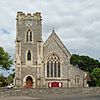 |
Stubbington 50°49′28″N 1°12′43″W / 50.824327°N 1.212055°W |
Anglican | II | This church was built in 1878 because Stubbington was growing fast. The original plan included a tower and spire, but only the tower was built, and that was 50 years later. The church was damaged by fire in 1968. | |
| Stubbington Baptist Church (More images) |
 |
Stubbington 50°50′00″N 1°13′11″W / 50.833322°N 1.219859°W |
Baptist | – | This church was registered in February 1996. | |
| Stubbington Methodist Church (More images) |
 |
Stubbington 50°49′39″N 1°12′46″W / 50.827556°N 1.212898°W |
Methodist | – | The first Methodist church in Stubbington was built in the mid-1800s. The current church building is from the early 1990s. | |
| Church of the Immaculate Conception (More images) |
Stubbington 50°49′20″N 1°12′59″W / 50.822211°N 1.216338°W |
Roman Catholic | – | This church started as a Mass centre for Catholics in Stubbington in 1976. It became a full parish church in 1985. | ||
| St Peter's Church (More images) |
 |
Titchfield 50°50′57″N 1°13′59″W / 50.849032°N 1.232944°W |
Anglican | I | The lower part of this church's tower dates back to around 700 AD, making it one of the oldest church buildings in Hampshire. It's a large church with parts from many different time periods. | |
| Living Word Church (More images) |
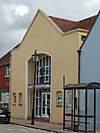 |
Titchfield 50°51′00″N 1°14′04″W / 50.849889°N 1.234308°W |
Evangelical | – | People have worshipped on this site since the early 1800s. It was originally a Congregational church. It's now part of the Living Word Church network. | |
| Our Saviour Lutheran Church |  |
Fareham 50°51′48″N 1°12′05″E / 50.8633954°N 1.2015219°E |
Evangelical Lutheran Church of England | – | This Lutheran church had its own building from 1972 until 2002, when it was sold and demolished. Since then, the church has met in the 10th Fareham Scout Hall. | |
| Warsash Gospel Hall (More images) |
 |
Warsash 50°51′14″N 1°17′29″W / 50.853849°N 1.291304°W |
Open Brethren | – | This chapel, also known as Swinton Hall, was built in 1908. It replaced an earlier school building that was used for worship by the Brethren group. | |
| Warsash United Reformed Church (More images) |
 |
Warsash 50°51′12″N 1°17′40″W / 50.853243°N 1.294319°W |
United Reformed Church | – | This church opened in 1890. An earlier chapel was built in 1845. The church's car park is now on the site of that older building. | |
| Whiteley Church |  |
Whiteley 50°52′51″N 1°15′29″W / 50.880734°N 1.257999°W |
Anglican | – | This Anglican church group meets in a community building in Whiteley, a housing area built in the late 1900s. |
Former Places of Worship
| Name | Image | Location | Church Group | Grade | What Happened to It | More Info |
|---|---|---|---|---|---|---|
| Crockerhill Mission Room (More images) |
 |
Crockerhill 50°53′19″N 1°10′26″W / 50.888576°N 1.173995°W |
Anglican | II | This mission room was still used for worship in the 1970s. It was an early 1800s building made of red and grey brick. It has now been changed into a house. | |
| Our Saviour Lutheran Church (original building) |  |
Fareham 50°50′51″N 1°12′20″W / 50.8474893°N 1.2055366°W |
Evangelical Lutheran Church of England | – | This building was built in 1972 for the Lutheran church. In 2002, the church sold the building and land. It was then torn down, and houses were built on the site. | |
| Fareham United Reformed Church (original building) (More images) |
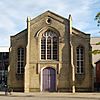 |
Fareham 50°51′08″N 1°10′41″W / 50.852301°N 1.178145°W |
United Reformed Church | II | This church was built in 1836 and used for nearly 160 years. It closed in 1994 when a new church opened. The building is now part of a pub. | |
| St Francis' Church (More images) |
 |
Funtley 50°52′08″N 1°11′55″W / 50.868790°N 1.198501°W |
Anglican | II | This church was originally meant to be a school and a chapel. It became a permanent place of worship in 1885. The last service was held in 2018, and it has now been changed into a house. |


